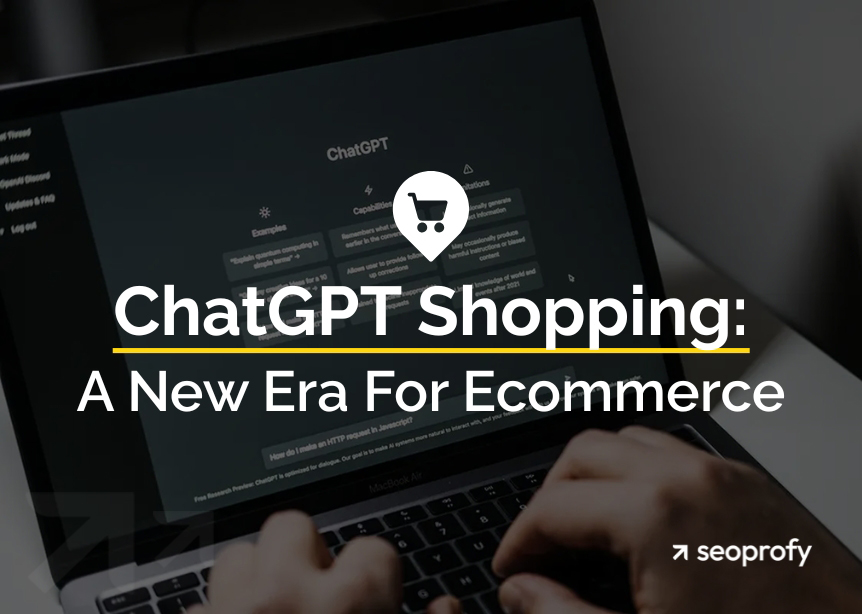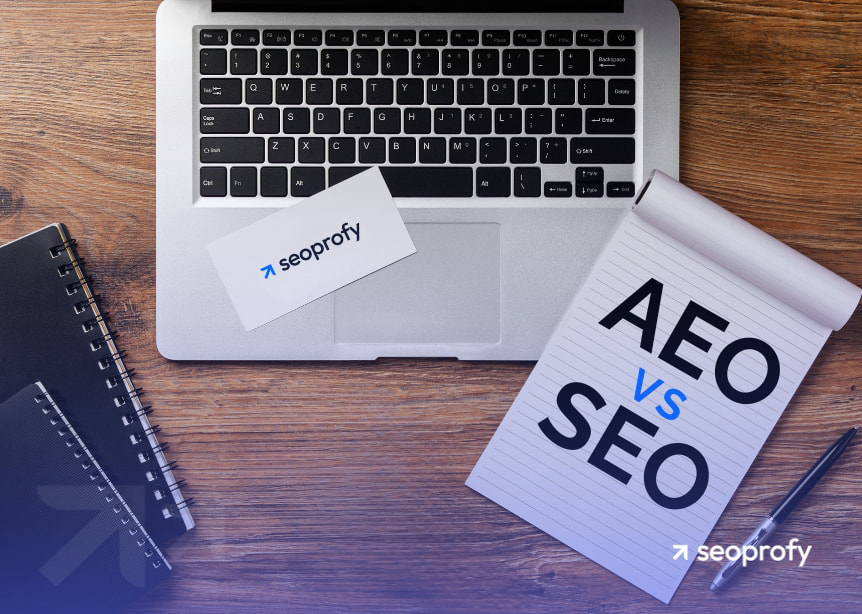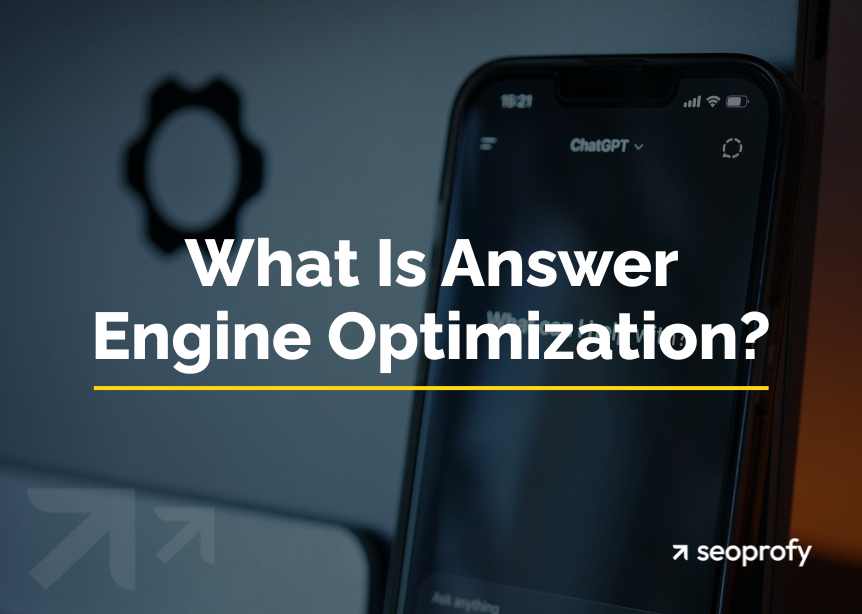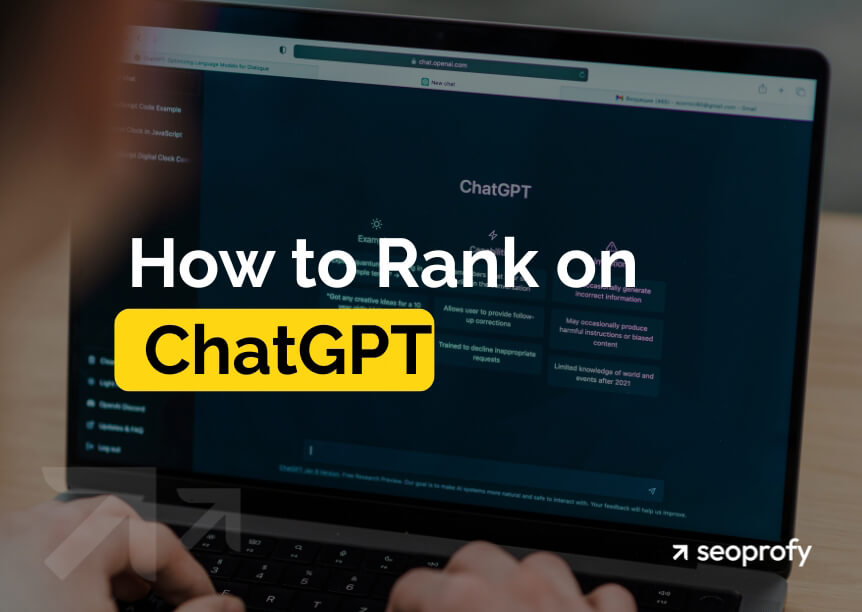AI search is changing yet again, only this time it’s bringing real shopping into the chat. You read that right. OpenAI has recently released ChatGPT Shopping, a new feature that lets users search, compare, and even buy products without ever leaving the tool.
For ecommerce teams, this isn’t a small update. It changes where product discovery happens and how visibility works. So, in this article, we’ll give you a detailed overview of this new feature and share some tactics you can try (based on our own tests) to help your products appear in ChatGPT results. Let’s get into it.
What Is ChatGPT Shopping?
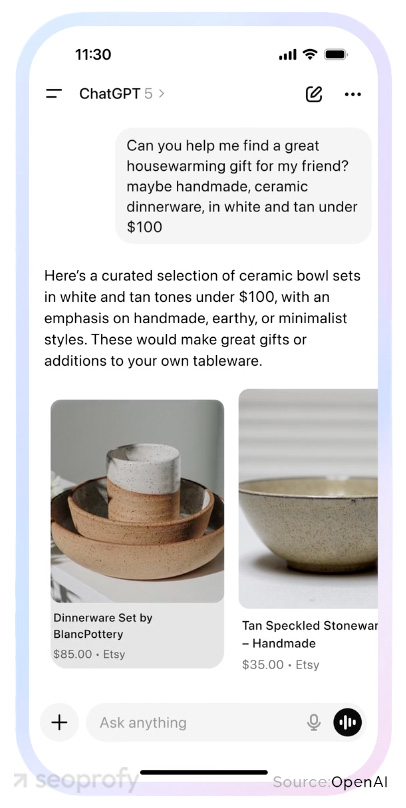
ChatGPT Shopping is a new OpenAI feature that allows users to discover and purchase products directly within their chat conversation.
The experience feels similar to Google Shopping but without the ads or sponsored results. According to OpenAI, all product suggestions are organic, unsponsored, and ranked solely by relevance to the user’s query.
It works like this: a user types something like “What headphones can I buy under $200?” and almost instantly receives a personalized set of product suggestions from multiple retailers. Each card shows images, price details, and some review highlights, such as good value for money.
If the merchant supports in-chat checkout, users can click “Buy” and complete the purchase securely via Stripe — without leaving ChatGPT. Under the hood, this feature leans on two key components:
- The model isn’t just pointing ChatGPT users to an external store. It surfaces results directly inside the chat. This turns ChatGPT into a unified discovery, comparison, and checkout hub—helping stores sell products through ChatGPT.
- OpenAI, in collaboration with Stripe, developed the Agentic Commerce Protocol (ACP) to power the instant checkout experience. The ACP allows merchants to stay in control of fulfillment, shipping, and returns while making the transaction possible straight from the chat.
Right now, the feature is available for both free and pro users in the U.S. and includes Etsy sellers. OpenAI plans to expand it to over a million Shopify merchants, including brands like Glossier, SKIMS, and Spanx. Future updates will extend support to more regions and introduce multi-item cart functionality.
How ChatGPT Is Reshaping the Purchase Journey
With ChatGPT Shopping, the entire buying journey now unfolds within a single conversation. People no longer need to start with a Google search. They ask a question inside the tool and immediately see product feeds with prices and images from multiple retailers.
By keeping discovery, comparison, and checkout in one place, ChatGPT significantly reduces friction in the buying process. Users don’t need to compare products across ten tabs or read reviews on multiple sites. They see a few trusted options, weigh them quickly, and often choose right away.
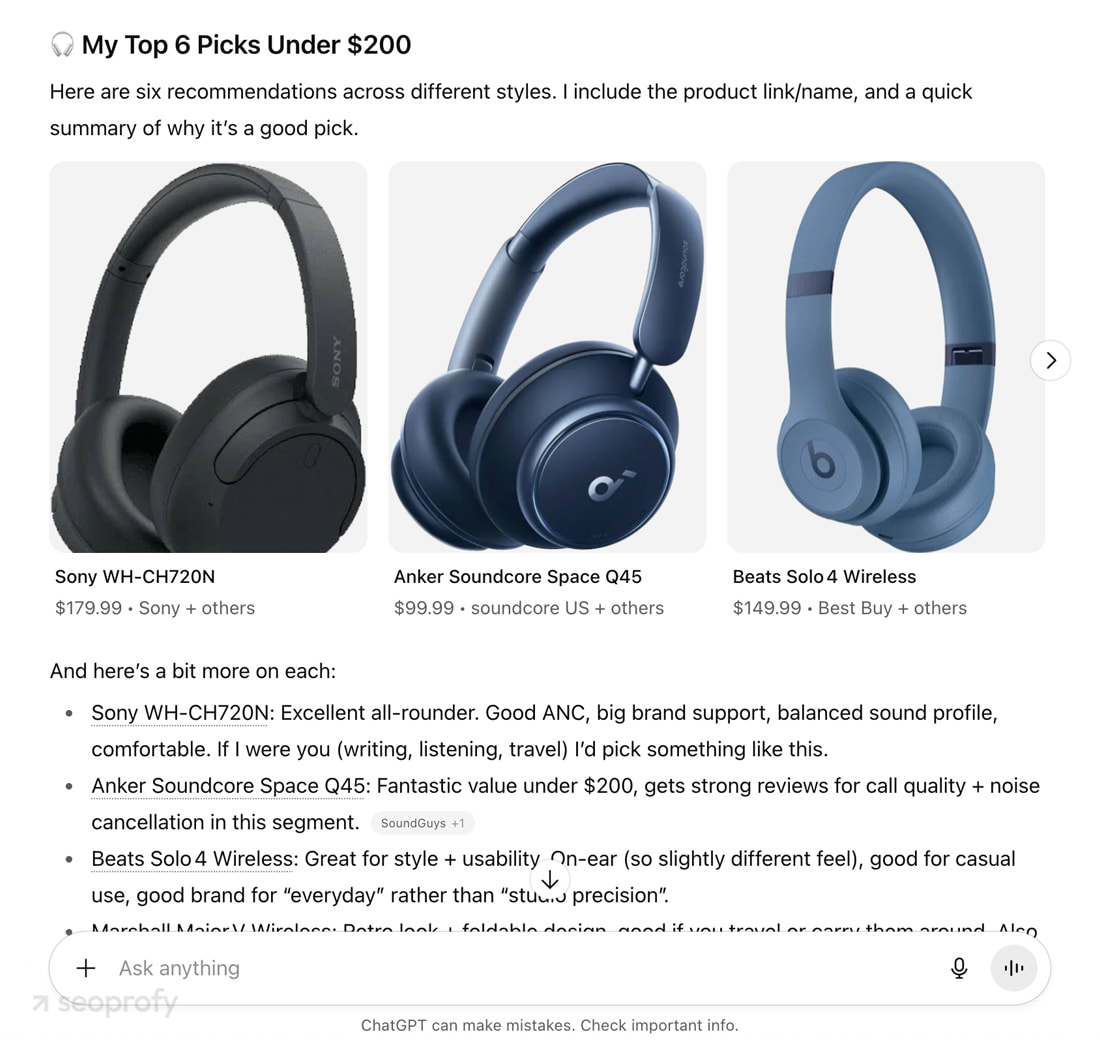
This speed is one of ChatGPT’s biggest advantages for ecommerce, dramatically shortening the decision-making funnel. And once the interface supports direct payments from more stores than Etsy, the number of clicks between discovery and purchase drops to one.
What’s more, ChatGPT’s user base keeps growing at a remarkable speed. More than 800 million people already use it every week, and as LLM adoption expands, traffic to these tools will continue to rise in the years ahead.
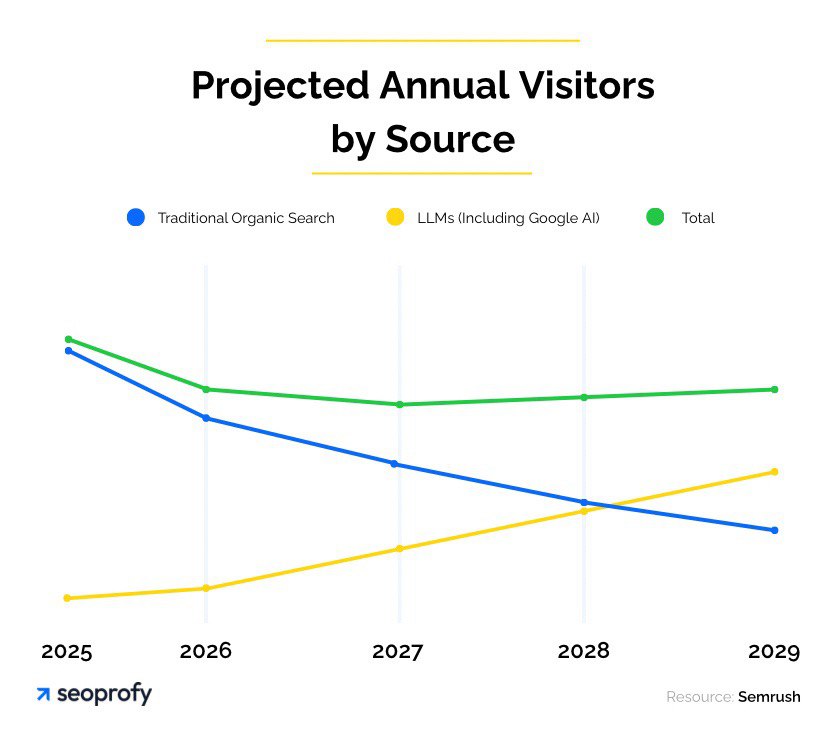
The takeaway here is simple. With ecommerce in ChatGPT, shoppers are moving part of their decision-making into these AI chats. The brands that show up there early will build awareness and trust sooner. Those who ignore it risk losing visibility as users spend less time searching in the traditional way.
5 Ways to Make Your Products Visible in ChatGPT Results
To help you become part of that first group, we’ll show you a few tested techniques on how to make your listings more visible in AI and get sales from ChatGPT.
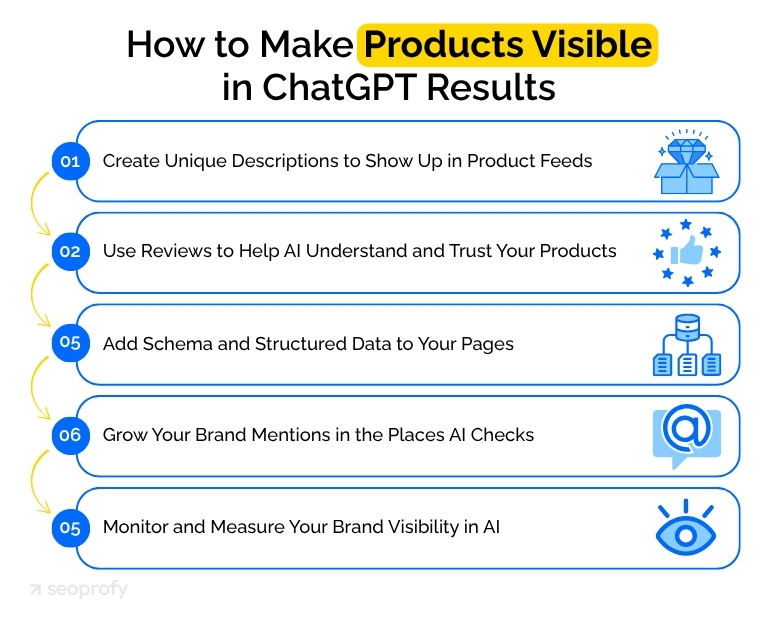
1. Create Unique Descriptions to Show Up in Product Feeds
ChatGPT reads product pages the same way it processes any other content. It looks for clues and distinct wording that explain what the item is and who it’s meant for. If your descriptions repeat what every other store says, the AI has no reason to feature your product over someone else’s.
Each product page should include unique, detailed copy that differentiates it from competitors. You basically want to give AI enough context to understand what the product is and who it’s best for. To achieve that, mention use cases, material, size, or feel in plain language that matches how people search, and include specific technical details when relevant.
For example, here’s what ChatGPT showed for the query: “What are the best spine-friendly office chairs?”
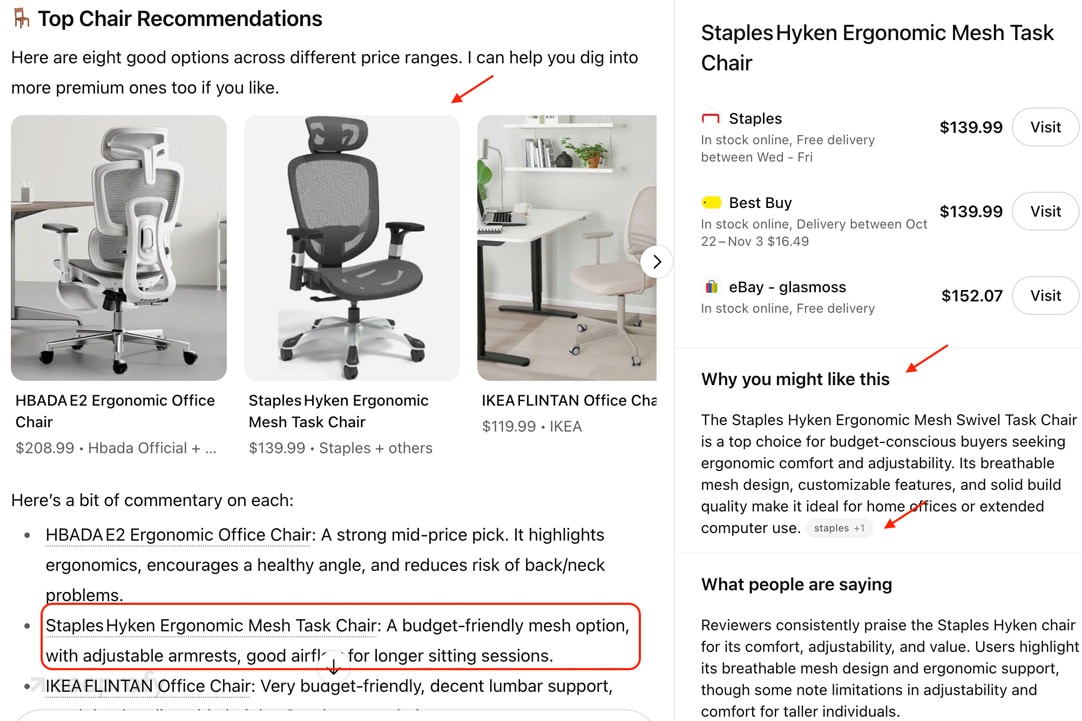
Clicking the second listing (a budget-friendly option) reveals a short summary on the right side explaining why users might like the product. These details were sourced directly from the product description on the Staples website.
If you visit that product page, you’ll see thorough copy that explains every nuance and benefit, from lumbar support to seat adjustability. That level of detail gives AI more than enough context to understand when the product matches the search intent.
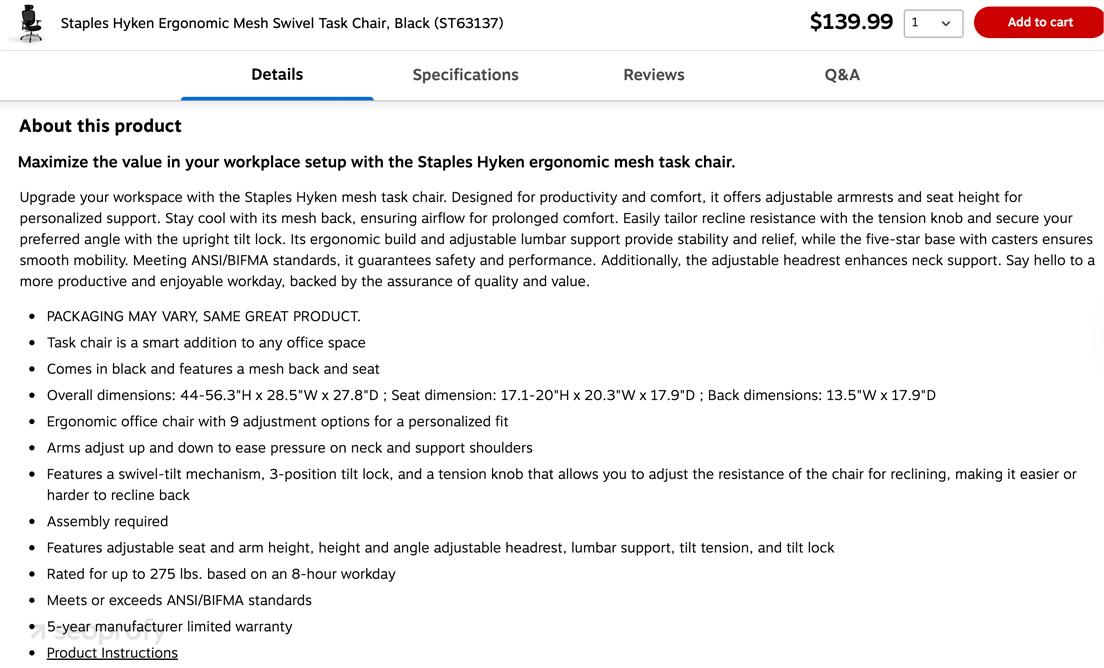
As we can see from this example, the more specific and natural your descriptions sound, the easier it becomes for ChatGPT to understand what the product offers and when it fits a user’s request. It’s the same logic as SEO, but now, the content needs to be read in a way that helps an AI model confidently recommend it.
2. Use Reviews to Help AI Understand and Trust Your Products
Customer reviews have long played a key role in retail SEO. What’s now becoming clear is that they also help AI models decide which products deserve to appear in user conversations.
The system doesn’t rely solely on product pages—it also analyzes external platforms like Reddit to learn how people describe their experiences. Each piece of feedback acts as a semantic signal that connects your product to specific search intent.
You can see this inside ChatGPT’s search results, too. You can see this in ChatGPT’s search results, where each product card often includes short quotes summarizing what customers liked most.
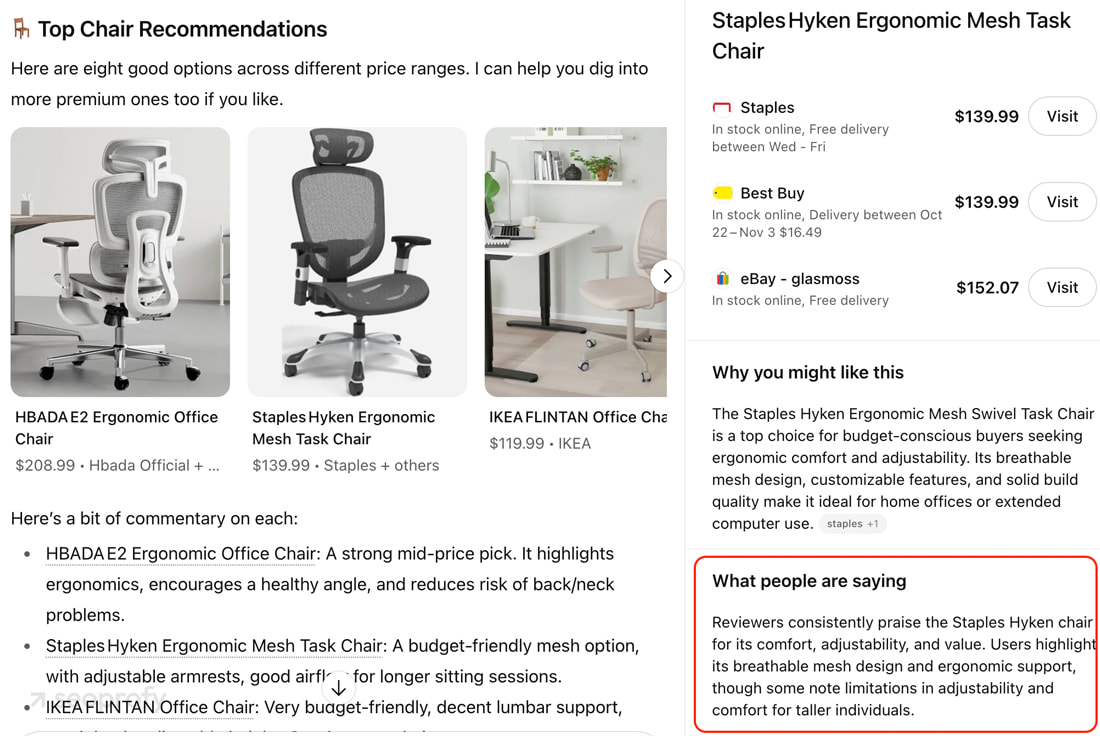
So, how do you use reviews to your advantage?
- Ask for descriptive feedback on how customers used the product and what they liked
- Keep them visible and place them directly on your product pages.
- Use review markup to help ChatGPT detect them faster (more on that later)
In short, customer feedback now does more than persuade shoppers. It teaches AI how to categorize and recommend your products, making them one of the strongest signals you can control.
3. Add Schema and Structured Data to Your Pages
Structured metadata helps ChatGPT understand your products in the same way it helps Google. It basically enables AI to read what’s on the page (details like price, availability, reviews, and key attributes) so the model doesn’t have to guess. It’s also one of the main tactics used in GEO and AEO, since it helps AI systems interpret content more precisely.
For retailers, this step is especially important. Product pages are often filled with design elements and dynamic fields that humans understand at a glance, but tools like ChatGPT need structure to interpret correctly.
Schema gives that structure and makes your product data easier to use inside its shopping results. The most relevant markup types you can use for ChatGPT Shopping are
- Product: defines the name, brand, description, and key specs
- Offer: includes pricing, currency, and stock availability
- Review and AggregateRating: connects user feedback directly to the product listing
- BreadcrumbList: helps ChatGPT understand the site’s structure and hierarchy
To make it work, check that your markup is consistent across all products. You can use tools like Google’s Rich Results Test to help verify that your code is correct before you hit Publish.
4. Grow Your Brand Mentions in the Places AI Checks
If you scroll through LinkedIn these days, you’ll notice one tactic that keeps coming up in every LLM SEO conversation — brand mentions. Many SEOs point to it as one of the most effective ways to build visibility in AI tools like ChatGPT.
And there’s a reason for that. These external references act like credibility signals. When AI systems see your products in multiple reliable places, they gain more context about what you sell and whether people trust you. It’s a similar logic to backlinks in SEO, but instead of ranking pages, AI uses these mentions to gauge reputation and relevance.
At the same time, these mentions are no longer limited to websites. YouTube, Reddit, podcasts, LinkedIn — every one of these platforms feeds information that models like ChatGPT use to understand what brands people recognize and talk about. As for the ways to grow your mentions, here are a few tactics you can try:
- Earn mentions on trusted sites and contribute to product roundups and curated lists
- Reach out to editors or YouTubers who review items in your category
- Join discussions on Reddit threads, Quora answers, or even comment sections on YouTube
- Invite customers to post about their experience or tag your products in videos and stories
The overall idea here is to stay top of mind. The more your name appears in places users trust, the higher the chance it shows up in product-related conversations later.
5. Monitor and Measure Your Brand Visibility in AI
Even though ChatGPT Shopping is new, you can already check how visible your business is inside these AI systems, as well as on third-party sites and forums. Here’s our pick of the best tools you can use for it:
|
Tool |
What it tracks |
Why it’s useful |
| Google Alerts | Mentions of your brand name or keywords on blogs and news sites | A simple starting point that sends email updates whenever your items appear on new pages. |
| Mention | Mentions across blogs, forums, social media, and news platforms | Helps you monitor multiple sources and filter results by keyword to see where your products get talked about most. |
| Awario | Mentions on social networks, websites, and forums, with sentiment and reach analysis | Useful for understanding not only where people mention your name or products but also how they describe them. |
| Ahrefs Brand Radar | Mentions and visibility inside AI tools like ChatGPT and Perplexity | Shows where your listings appear across AI platforms and how often they’re cited in generated responses. |
| BrandMentions | Real-time alerts and link discovery from a wide range of web sources | A good option if you want broader coverage than Google Alerts without the higher cost of enterprise tools. |
| F5bot | Mentions on Reddit and Hacker News | A free, lightweight tool that sends alerts whenever your product appears in public Reddit threads. Since Reddit is one of the most cited sources in AI responses, it’s worth keeping on your list. |
It also helps to explore the chats yourself and see how things look from a shopper’s point of view. See which names appear first and what details they include. That small bit of research shows how visible your products are inside ChatGPT and how they compare to other retail stores in your category.
Overall, checking where your brand shows up when people use ChatGPT for ecommerce helps you understand how AI systems interpret it and whether your recent PR or content efforts are showing results. Many teams treat this as the first step before running a full AI SEO audit to see how their presence changes inside these tools.
Early adopters already win more conversions and sales from AI. We’ll help you take that advantage further and see:
- Better visibility in AI results
- More high-quality leads
- Increased store revenue

What the Future of Shopping Means for Your Marketing
From what we’re seeing at our SEO agency, ecommerce inside ChatGPT is starting to change how people browse and buy. The model now acts as a shopping assistant, and as these tools become part of everyday browsing, the line between searching and buying continues to blur.
It’s also likely that new storefronts will appear inside chat apps or marketplaces that follow a pay-to-show logic, where brands compete for space in those results. All these changes mean that online stores will have to adapt their marketing efforts for the future. And the tactics we shared with you today are a good starting point for that.
For more advanced support, consider our ecommerce SEO services. We’ve been testing new approaches ever since AI tools came out and have already worked with dozens of online stores to prepare for what’s next. Our team uses hands-on AEO expertise and data-driven workflows to help you remain discoverable and profitable, regardless of how shopping continues to evolve.





